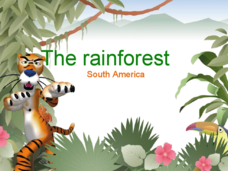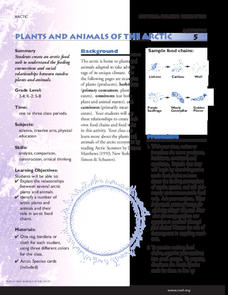Curated OER
The Netherlands
Students create a journal for an imaginary trip around the Netherlands. They identify animals and plants that live in the Netherlands and describe its landscape. In addition, they summarize and present historical information about an...
Curated OER
Portugal
Students create a nature journal for an imaginary trip around Portugal. They recognize regional differences, identify animals and plants that live in Portugal, and describe the landscape of Portugal. In addition, they order major events...
Curated OER
Flutterings and Flowers
Fourth graders investigate the significance of natural resources and the habitats of butterflies. They create a list of their own favorite foods, then watch a video about habitats. Students identify things in the video that animals and...
Science Matters
Blubber Gloves: It’s All About Insulation
Instill the concept of adaptation with the help of Blubber Gloves—ziplock bags, shortening, and duct tape. Scholars discuss how animals and plants keep warm in polar regions, record their predictions, and try on their Blubber Gloves to...
American Museum of Natural History
What's This? Feeding
Some species have pretty creative methods for catching food. Young scientists learn about some interesting ways organisms get the nutrients they need by navigating an online interactive lesson that would be suitable for a remote learning...
Curated OER
Book: Finland
Students, after reading Chapter One in the book, "Finland," design and create in the computer lab a wildlife journal from an imaginary trip to Finland. They include different animals and plants that live in Finland as well as describing...
PreKinders
Forest Word Cards
Explore the animals of the forest with a set of vocabulary cards. Each half-page card features the name of an animal with a corresponding photograph, as well as a few plants.
Curated OER
Plants and Animals Word Search
For this science worksheet, students examine labeled pictures of birds, plants and mammals. Students locate the names in a word search puzzle.
Curated OER
Name Match: Plants
In this name match worksheet, students match up fourteen different types of plants to their formal names by drawing a line from one to the other.
Curated OER
Local River Life
Students identify rivers in their county, state, or province, and
research various kinds of animals and plants living in or near the rivers.
They write short summaries about the animals and plant life, draw pictures, and compile...
Curated OER
Plants 1: Plant Parents
Students review their prior knowledge on plants. In groups, they compare and contrast the difference between reproducing asexually and sexually. Using the internet, they research how some plants can be forced to produce asexually.
Curated OER
Animals A to Z: Manatee
In this manatee worksheet, 3rd graders will read 10 facts about a manatee to gain an understanding of the animal's characteristics. Students will locate 10 errors of punctuation, capitalization, spelling, and grammar.
Curated OER
The Rainforest: South America
What can one expect to see in the South American rainforest? Find out where humans sleep, what animals they encounter, what kind of plants they'll see, and what dangers lurk in the tall grasses and dense forests. This is a simple and...
Chicago Botanic Garden
Migration, Adaptation, and Changing Climates
It is easy for humans to adapt to changing environments, but how do animals and plants do it? Classes discuss how plants and animals deal with environmental changes in the second of seven lessons. Through questions and discussions,...
Science Geek
Build a Food Web Activity
Entangle your life science class in learning with this collaborative food web activity. Using pictures of the plants and animals native to a particular ecosystem, young biologists work in small groups to construct visual representations...
Global Change
Impact of a Changing Climate on the Pacific Walrus
How many of us can say they've seen a Pacific walrus? Not many and one of the reasons is the impact of climate change on their aquatic environment. Children get to think about the food web of the Bering Sea by creating an actual web with...
National Wildlife Federation
Plants and Animals of the Arctic
The Arctic food web may be more limited than other environments, but it has all the same components. With an interactive activity, pupils assume the roles of the components of an Arctic food chain. They move around and link themselves to...
ARKive
Temperate Rainforest in the Pacific Northwest
Explore the amazing temperate rainforest of the Pacific Northwest. Your class starts by investigating the animals and plants of the Northwest, specifically Washington, and then research an animal population common to the area. In small...
Ocean Explorer
Architects of the Coral Reef
Coral Reefs are the focus of a life science lesson plan. Upper graders look at how coral reefs are formed, how the animals and plants reproduce, and the variety of ways that humans benefit from coral reefs around the world. Groups of...
Curated OER
Coral Reef Community
Students explore the coral reef. In this food chain lesson, students study the plants and animals of the coral reef and how they each play a role in that ecosystem. They participate in a class play to demonstrate the types of animals in...
Curated OER
Rocky Shore Food Web Drama
Students explore food chains. For this ecosystem lesson, students discover how plants and animals rely on each other for survival. Students research the rocky shore ecosystem and create a skit representing the ecosystem.
Curated OER
To Eat or Not to Eat?
Young scholars identify various parts of plants and determine which parts people eat. They conduct a celery stalk experiment in which they determine the value and use of the stem, and how it helps the plant to meet its needs. Students...
Curated OER
"Five Little Seeds"
Fourth graders complete various activities related to the plant life cycle. They read the book "The Tiny Seed," read and discuss the poem "Five Little Seeds," complete a "Plantenstein Mystery" and other online activities, write and...
Curated OER
Water, Water Everywhere (Pond Animals)
Second graders examine the characteristics of animals who live in a pond environment. In groups, they describe the various stages in the life of a frog and identify the characteristics of other pond animals. Using this information,...
Other popular searches
- Plants and Animals
- Arctic Plants and Animals
- Aquatic Plants and Animals
- Coastal Plants and Animals
- Artic Plants and Animals
- Plants and Animals Needs
- Plants and Animals Interact
- Desert Plants and Animals
- Plants and Animals Die
- Attic Plants and Animals
- Comparing Plants and Animals
- Animals Plants and Water

























